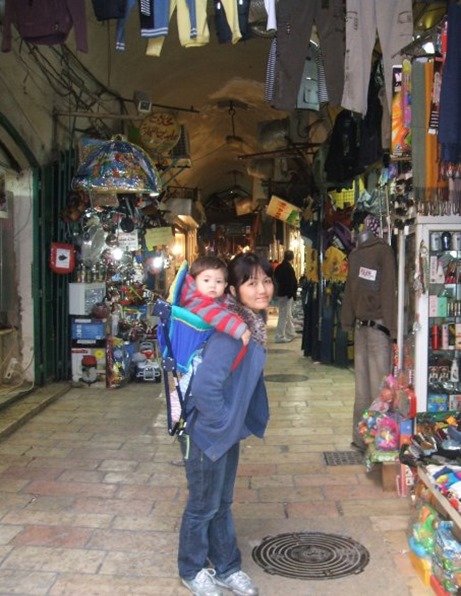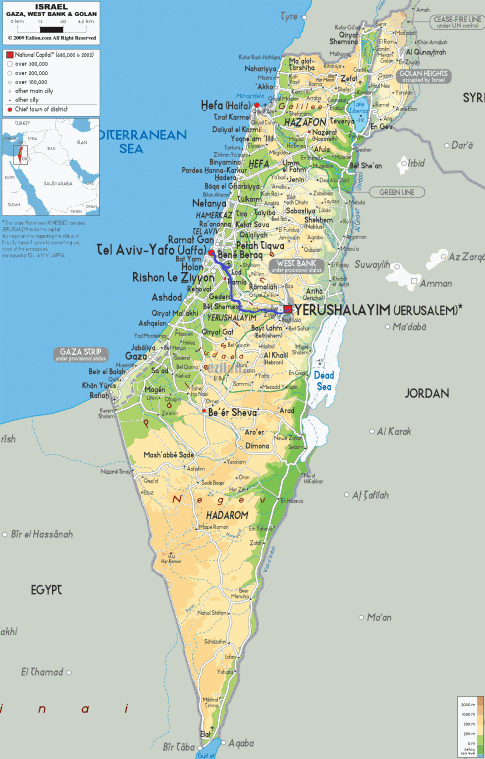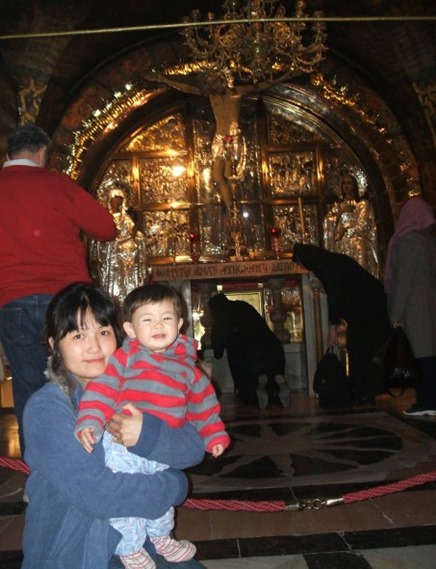Greetings!
And what a week it has been. Last Saturday whilst exploring the Roman city of Wroxeter, I tripped backwards and knackered my knee (again). The result: four hours in A&E and a week sat on the settee with nothing to do except read books and type up travelogues. The results: my Welsh travelogue A470 which tells the story of my driving expedition from the top to the bottom of Wales with my brother last year is completed and I’m making good progress in writing up my trip around Ireland last year. Oh yes, and I’ve been able to listen to every over of England destroying the Aussies in the Third Ashes Test. Every cloud…
Keep travelling!
Uncle Travelling Matt
Links to other parts of the travelogue:
Sacred Pilgrimage
Part 2: Ash Wednesday in Jerusalem
Part 4: Exploring the Old City
Part 7: Up the Mount of Olives
Part 8: Further explorations of Jerusalem
Secular Pilgrimage
Part 2: An Introduction to Kibbutz Living
Part 4: The Silence of the Desert
Part 6: Tearing down the Wall!
Part 7: Beautiful (?) Beersheva
Ash Wednesday
We were up early and glad to be leaving Tel Aviv, that soulless city with its abysmal hotel. To make things worse, Thao was suffering from an allergic reaction to something or other and so we had our taxi driver go out of his way to a pharmacy which cost more but at least stopped the complaints. Like all our drivers, he was an Arab and a friendly one at that. He chatted about his toddler son and a Filipina regular customer, (he’d assumed the Spouse was Filipino), who only left the house when he was outside for fear of the police, (she was an illegal visa-overstayer).
I decided that the train was the best way to travel to the Holy City despite it being much longer, partially because neither Thao nor I particularly like bus travel, partially because the trip was reputed to be rather scenic, partially because I like trains and partially because I’d never done it before. The Ottoman railway line to Jerusalem had only been reopened four years before – since I’d last visited Israel has undergone a rail revolution with several passenger lines being opened and what’s more, it isn’t over yet; a high-speed line between Tel Aviv and Jerusalem is currently under construction and there are plans for a line all the way down to Eilat; all good in my opinion.
As our diesel rumbled out of Tel Aviv, through Lod, (birthplace of St. George of dragon-slaying fame), Ramla, (the only Arab-founded town in Israel, although looking remarkably like all the Jewish-founded towns) and Beit Shemesh, I tried to focus my thoughts in a more religious manner as befits the journey towards Jerusalem, the City of Peace, Al-Qud, the holiest place on the planet. I started by reading a little of Journey of a Lifetime,[1] a book that I’d borrowed from the prison chapel, an account of a 1950s pilgrimage to the Holy Land, but it proved to be a poor read and so I laid it aside and delved into The Holy Land,[2] a Catholic guide to the sites of pilgrimage that the Roman Catholic Deacon at the prison had leant me. This proved to be far more interesting and I began to get a feel for the land we were visiting. By this time we had entered a desolately beautiful ravine with no roads and only a trickle of a stream at its bottom that the single track railway kept criss-crossing. It took very little imagination to be transported back not just to the time of Christ, but well before that, to the landscape that Elijah roamed and David hid in. I took out my rosary to focus my thoughts but found my meditations much disturbed, jumping from Elijah, to prayers for Christian friends around the globe who have never had the chance to come to the Holy Land, to John the Baptist who preached in a similar wilderness, to David who fought in it. On previous pilgrimages, focussing had been easy; there’d only been one story to meditate upon, such as that of Our Lady and Richeldis at Walsingham or that of St. Kevin at Glendalough, but here in the land of both the Old and New Testaments, (not to mention an extremely eventful recent history as well!), there was simply too much to think about and now I understood why so many Christians focus solely on Christ during these trips – they can’t take in any more than that.
We continued down that valley right until the end of the journey when vast new housing developments appeared on the cliff tops above us, Jewish bastions against the Palestinians, in place of the scattered Arab dwellings that had lined the previous few miles,[3] and we drew into the brand-new Jerusalem Malha terminus.[4]
We took a taxi to the Old City that, on an inflated rate, took us on a round-robin trip that eventually dropped us at our destination. Thao was not best pleased, I too and in our hurry I left our Lonely Planet Israel on the dashboard. Bad enough that we had no guidebook now, but what made it worse was that it had been the 1995 edition, a relic from my very first trip to Israel, well-thumbed and used. I have developed an attachment to my old guidebooks and the loss of this one was especially hurtful as it was permeated with memories and alas Lonely Planet guidebooks have gone downhill rapidly in terms of content since 1995 so any replacement was always going to be inferior as well as costly.
I had booked us into a hotel that Lenin had recommended before flying out called the Golden Gate. That was all well and good, but finding it without a guidebook was something else. I had an address on the Suq Khan ez-Zeit but several searches along that street did not reveal its location. In the end I went to the Lutheran Church and a guide kindly showed me where it was. Then, with the Golden gate receptionist in tow, I went to pick up Thao and Tom from the café where they’d been waiting and together we made our way to the hotel.
Lenin had made a wise choice in recommending the Golden Gate to us. It was cheap yet clean and the room spacious. Most of all though, it had character, both ancient, (the building was a thousand years old), and modern, in the form of Sarra, an American convert to Islam who was friendly yet somehow odd at the same time. In her own way she reminded me of those British girls who go out to Greece on holiday, fall in love with a Tassos or Stavros and then stay there long after Tassos or Stavros has left them for another passing tourist, part of the fixtures, though never part of the local society which tolerates yet never quite accepts them. Sarra mind you, in her full hijaab dress, might not have been enamoured with this comparison and so I never once put it to her.
Settled in, we went out to eat in a nearby Arab restaurant. This meal was special for me as it was Ash Wednesday, the start of Lent and during Lent I don’t eat meat. But Lent doesn’t start until you’ve attended Mass on Ash Wednesday and on this particular Ash Wednesday I was intending to attend Mass in none other than the holiest church on earth. Therefore, the midday shwarma that we were served tasted even better than it actually was, for it would be the last meat that I’d touch in Israel and signified something very special.
 Tom and Thao on the Suq Khan ez-Zeit
Tom and Thao on the Suq Khan ez-Zeit
At the heart of the Christian faith is one man, Jesus of Nazareth, and His message, and this message is symbolised best by two places; Calvary, the site of the cross upon which He died and the Empty Tomb from which He overcame death and was resurrected. For a Christian these are the things that matter, for it is that death and resurrection that set Him apart from all the other great prophets and religious figures that the world has produced, and that death and resurrection that has set mankind free and confirmed God’s love for His people. And quite amazingly, both sites are today contained within one great building, the Church of the Holy Sepulchre.
When I first visited the Holy Sepulchre back on the 22nd February, 1997, I was in Jerusalem on a day trip with Elton and Adrienne Netto and Simeon and Pepi Kovatchevi, all friends from Kibbutz Revivim. I was not particularly religious at the time although I described myself as a Christian on the forms and knew the Bible stories well after spending hours reading and looking at the pictures of The Children’s Illustrated Bible as a kid. I went that time not as a pilgrim, but a tourist and my lasting memory was one of surprise that two sites that I’d always assumed to be about a mile apart, (I’d always imagined the tomb to be some distance out of the city in a shallow wooded valley). That of course brings into question the issue of whether the sites of pilgrimage are the actual sites of the events, but that is a huge topic that could fill a whole book but not this one.[5] In pilgrimage you see, what matters is what these sites symbolise, not historical accuracy despite that being hard for many a modern mind to understand. So it was that with Thao and Tom in tow I went to Calvary and prayed at the site of the Cross. Since I had come to Jerusalem in order to say thank you for Tom’s arrival – after years of waiting and miscarriage with complications we did wonder as to whether he would ever arrive – then I was glad to have fulfilled my promise so soon.
We walked to the Tomb together but the queue was long and both Thao and Tom were tired so they left and I stayed on to immerse myself in this, the holiest of all places, further. I explored the side chapels and bought mementoes from the Coptic tent at the rear of the tomb for Christian friends worldwide who would never have the opportunity to come there themselves. Then I explored the alcoves behind the tomb where there is a tomb that tradition states is that of Joseph of Arimathea. Whilst there I came across a sight that quite shocked me: a Muslim girl in a headscarf facing Mecca on her prayer mat and praying. When I first saw her I must admit I felt a little angry: what right had she to invade the holiest place of my religion, only yards from the Tomb itself, and then pray to somewhere else in far-off Arabia? Those thoughts however, evaporated in an instant when I just thought about it all for a second. Hadn’t Christ’s death been for everybody and don’t the Muslims respect Him as a prophet? And doesn’t it say something really positive about Christianity that a Muslim can come within yards of its holiest shrine and pray in their own fashion and not be hassled or worse? After all, Christians – or followers of any other religion for that matter – are not even allowed within the boundaries of the city of Mecca, let alone the shrine itself and, if they prayed openly as Christians in any part of Saudi Arabia, then in all likelihood a holy war would break out. No, upon reflection I was glad that I had seen that Muslim girl praying in that place; it said a lot about a religion based on love and it challenged the baser instincts in man.
The Holy Sepulchre is in many ways not a church but a collection of churches all under one roof yet administered by different denominations. The central section is Greek Orthodox but the Armenians, Copts and Syriacs all have chapels as well. The world’s largest Christian church, the Roman Catholic, also has sections but they are small in comparison with those held by the Greeks. They should consider themselves lucky mind; the Protestant churches, (who make up approximately a third of all Christians), have nothing. Not that that bothered me particularly, for whilst I technically am a Protestant, I tend to attend Catholic Mass when abroad and on that particular day there was one on in the Franciscan Chapel of the Apparition at the side of the Empty Tomb.
How the other denominations organised their services I don’t know, but the Catholics did theirs on a booking system whereby pilgrim groups could reserve a slot and so it was that the Mass I attended was in Portuguese and I shared it with several coachloads of worshippers from Lisbon.
Not that I minded. It was honour enough just being able to celebrate in that place and one of the great things about the Mass is that you know where you are with it whatever the language. As the priest intoned, I tried to meditate but it was difficult to concentrate as like with my meditations on the train coming into Jerusalem, there was simply too much to take in. Nonetheless, I persevered and returned to the island and cave that I had visited at Walsingham, but then I travelled further, to a hilltop above the cave from which I could see the island, sea and mainland beyond. In the same church as Calvary, it was a fitting journey.[6]
Back in reality though, there was much to think about also. As I heard the muezzin from the adjacent mosque calling the Muslims to prayer during Mass, I thought about this remarkable church, unspectacular compared to many European cathedrals, reeking of incense, dark, and in places totally dilapidated, yet with an atmosphere all of its own, labyrinthine, Western, Eastern, truly unique and, despite the crowds, a place of quiet and reflection.
My reflections were broken by the Peace. This is the one part of the Mass that does differ across the cultures and I always find it interesting to see how the locals approach it. In England, it is the cue for a hearty handshake whilst in Vietnam the congregation always looked uncomfortable and annoyed at being asked to interact with their fellow worshippers and merely afforded one another a cursory nod. The Portuguese however, much to my surprise, all waved at each other enthusiastically. It was altogether quite pleasant.
After the Peace I prayed for Christian friends around the world and for my own family. Then I took the host in the holiest church on Earth and that done, I returned to the hotel a content man.
Thao is a difficult person to please, particularly regarding food. She did not fancy more of the same fare as before and so we went on a stroll to locate something different. We walked up through the Old City to the Jaffa Gate and then through a plush new shopping complex to the New City where we found a Japanese restaurant of middling quality in which to dine. This short trip made me realise that I did not know Jerusalem at all; on my two previous visits I’d not left the Old City and even within the walls had explored either the Christian or Armenian Quarters.[7] As we walked back outside the city walls full of ramen and sushi, I resolved to correct that omission post-haste.
Next part: Bethlehem with a Baby
[1] Author: Carlyle Witton-Davies
[2] Author: David Baldwin
[3] In the past it is recorded that the inhabitants of these villages often threw stones at the passing Jewish trains although thankfully there were no such episodes on the day that we rumbled by.
[4] The former terminus was near to the Old City but it had not been rebuilt due to objections from the local residents about potential noise pollution.
[5] Ah, but what a subject it is! In the Holy Land there are two sites claiming to be the Empty Tomb, two Upper Rooms, (where the Last Supper took place), and no less than three contenders for Emmaus. Since Christian holy sites only began to get popularised some three centuries or so after the death of Christ, then the accuracy of all of them is questionable, although ‘The Holy Land’ by David Baldwin argues that St. Helena of Constantinople – mother of Emperor Justinian and the greatest holy place identifier of them all – came to Jerusalem in 326AD she merely officialised sites of traditional veneration that could easily have been prayed at first by the disciples. As for the Holy Sepulchre, Helena identified Calvary as being the spot where Hadrian’s temple to Venus and Jupiter stood, (built to thwart Christians she said), and excavations revealed three crosses and the tomb that Joseph of Arimathea gave for Christ’s body to be placed in. Therefore, of all the Holy Places, the Holy Sepulchre is said to be one of the most historically accurate. The first church on the site was built in 326AD under Helena’s supervision.
[6] See Walsingham Pilgrimage travelogue.
[7] I also realised just how small the Holy City is. Before I’d always felt it to be huge and labyrinthine, but on both counts it is beaten hands down by Fez, Marrakesh and countless other Arab cities. In reality, Jerusalem’s Old City is small, compact and easily navigable.




No comments:
Post a Comment